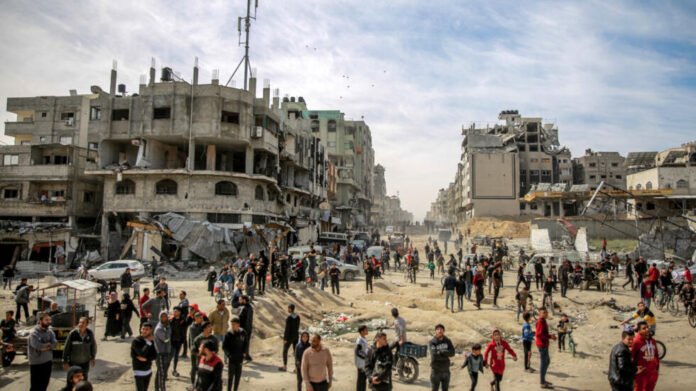The United States has announced plans to airdrop humanitarian aid into Gaza, a move aimed at providing much-needed assistance to the Palestinian territory. The decision comes amidst escalating tensions and humanitarian crisis in the region, exacerbated by recent conflict and political instability.
The airdrop of humanitarian aid into Gaza represents a significant step towards alleviating the suffering of civilians who have been disproportionately affected by the ongoing crisis. By delivering essential supplies such as food, medicine, and shelter materials directly to those in need, the United States aims to address urgent humanitarian needs and provide relief to vulnerable populations.
The decision to airdrop humanitarian aid into Gaza underscores the commitment of the United States to support the well-being and safety of civilians affected by conflict and humanitarian emergencies. It reflects a recognition of the dire humanitarian situation in Gaza and the urgent need for international assistance to address the crisis.
Humanitarian aid airdrops have proven to be an effective means of delivering assistance to populations in inaccessible or conflict-affected areas, where traditional methods of aid delivery may be hindered by logistical challenges or security concerns. By utilizing aircraft to deliver aid directly to affected areas, humanitarian organizations can bypass barriers to access and reach communities in need more quickly and efficiently.
The airdrop of humanitarian aid into Gaza is expected to provide immediate relief to civilians who have been struggling to access basic necessities due to the ongoing conflict and blockade. With food shortages, limited access to clean water, and inadequate medical supplies exacerbating the humanitarian crisis, the delivery of aid via airdrop is a critical lifeline for those in Gaza.
In addition to addressing immediate humanitarian needs, the airdrop of aid into Gaza also serves as a symbolic gesture of solidarity and support for the Palestinian people. It sends a clear message that the international community stands with Gaza in its time of need and is committed to providing assistance to alleviate the suffering of civilians affected by conflict and crisis.
However, while the airdrop of humanitarian aid into Gaza represents a positive step towards addressing urgent humanitarian needs, it is important to recognize that it is not a long-term solution to the underlying issues driving the crisis. Sustainable peace and stability in Gaza can only be achieved through concerted efforts to address the root causes of conflict and to promote dialogue, reconciliation, and respect for human rights.
In addition to providing humanitarian aid, the United States and the international community must also work towards advancing a political solution to the Israeli-Palestinian conflict that addresses the legitimate aspirations and grievances of both parties. Only through a comprehensive and inclusive peace process can the cycle of violence and suffering in Gaza be brought to an end and a brighter future for all Palestinians and Israelis be secured.
The decision to airdrop humanitarian aid into Gaza also comes at a time when the region is grappling with the aftermath of recent conflict and facing mounting challenges in the delivery of essential services. The destruction of infrastructure, including hospitals, schools, and water facilities, has further compounded the humanitarian crisis in Gaza, leaving many without access to basic services and in urgent need of assistance.
The airdrop of humanitarian aid into Gaza is therefore not only a response to the immediate needs of civilians affected by conflict but also a recognition of the longer-term challenges facing the region. By providing essential supplies directly to those in need, the United States and the international community are taking proactive steps to address both the immediate and underlying causes of the humanitarian crisis in Gaza.
Moreover, the airdrop of humanitarian aid into Gaza serves as a demonstration of the United States’ commitment to upholding humanitarian principles and providing assistance to vulnerable populations in times of crisis. It underscores the importance of international solidarity and cooperation in addressing humanitarian emergencies and supporting the rights and dignity of all individuals affected by conflict and displacement.
In addition to providing humanitarian aid, the United States and the international community must also prioritize efforts to promote reconstruction and development in Gaza, with a focus on building back better and strengthening the resilience of communities against future crises. This includes investing in infrastructure, healthcare, education, and livelihood opportunities to support the long-term recovery and well-being of the Palestinian people.
Furthermore, the airdrop of humanitarian aid into Gaza highlights the need for sustained diplomatic efforts to address the underlying causes of the Israeli-Palestinian conflict and advance a just and lasting peace in the region. This includes supporting efforts to resume negotiations towards a two-state solution based on the principles of international law and relevant United Nations resolutions.
Also, while the airdrop of humanitarian aid into Gaza is a positive step towards addressing immediate humanitarian needs, it is only one part of a broader effort to promote peace, stability, and prosperity in the region. By addressing the root causes of the crisis and supporting the rights and dignity of all individuals affected by conflict, the international community can help build a brighter and more hopeful future for the people of Gaza and the wider region.

